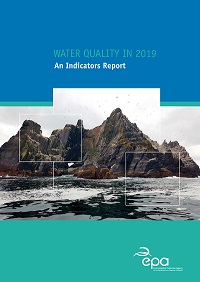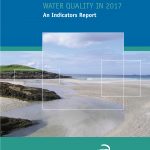The EPA has today released the Water Quality in 2017:…
Water Quality Indicators report launched: Ireland’s water quality needs to be better protected
15 December 2020: The Environmental Protection Agency (EPA) has today published the Water Quality Indicators Report 2019 which provides an assessment on Ireland’s surface water and groundwater quality.
- Just over half of Irish surface waters are in a satisfactory condition.
- Nutrient concentrations in waters are too high and the trends are going in the wrong direction.
- Nitrate concentrations are now increasing in nearly half of our river and groundwater sites.
- Phosphate levels are increasing in a quarter of river sites.
- Concentrations of nitrate are highest in the south and south east of the country where the main source is agriculture.
- Delivering on the key objectives of Ireland’s River Basin Management Plan and targeted action at local water catchment level is key to improving water quality.
The main threat to water quality is the presence of too much nutrients, such as phosphorus and nitrogen, which come primarily from agriculture and waste water. Over one third of rivers, and a quarter of lakes are failing to meet their environmental quality standards for nutrients. Over one fifth of our groundwater, estuarine and coastal water bodies have high nitrogen concentrations.
Just over half of rivers and lakes are in high or good biological quality. The rivers surveyed in 2019 have shown more improvements than declines overall, which is welcome, however further action is needed to return waters to a satisfactory condition.
Ireland’s water quality needs to be better protected is the main finding of ‘Water Quality Indicators Report 2019’ which provides an assessment of Ireland’s surface water and groundwater quality. To read the report visit https://t.co/d9FVn265XW#water #waterquality pic.twitter.com/PdRtHUTzs3
— EPA Ireland (@EPAIreland) December 15, 2020
Clean, healthy water is essential for our economy, our aquatic wildlife and for our health and well-being. However, this assessment shows that our water environment remains under considerable pressure from human activities. Of most concern is the continued upward trend of nitrate concentrations. The problem is particularly evident in the south and southeast of the country where the main source is agriculture.
EPA Director Dr Micheál Lehane
We need urgent and effective action to ensure that the decline in water quality is halted and to restore those water bodies that have declined in quality
Elevated nutrient concentrations are contributing to pollution in our freshwaters and estuaries and causing difficulties with drinking water standards in some areas. Urgent action is now needed to reduce nutrient inputs from agriculture. Measures need to be targeted at the critical source areas where nitrogen and phosphate problems occur. There is a lot of good work happening at a local level to improve water quality and this needs to be scaled up to deliver the improvements needed.
Mary Gurrie, Programme Manager
The River Basin Management Plan, the new Common Agricultural Policy Strategic Plan and the full implementation of the EU Farm to Fork Strategy offer significant opportunities to achieve improvements in water quality, while delivering multiple benefits for the environment including for climate, air quality and biodiversity
Learn more:
The report is available on the EPA website and the accompanying data used in the water quality assessments are available on www.catchments.ie An infographic is also available.









